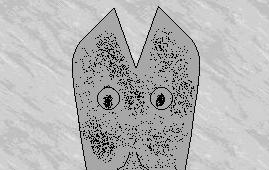Okay, you want to be somebody, but you have no discernible skills or talent. A problem? Not necessarily. You can always start your own magazine. I know, I know – 90 per cent of new magazines fail within their first two years. But, yours will be different. Why? Because you will follow the simple rules below and be magically transformed from an insufferable dweeb to the hippest publisher going.
Trust me.
A – Artists: only support and promote artists that nobody has ever heard of. If necessary, make them up. If somebody challenges you on the existence of an artist you’ve made up, claim The Hype Machine destroyed him or her before they had a chance. If an artist you have given favourable coverage to is mentioned in another publication (People, say, or The Journal of Internal Podiatry C), accuse her or him of selling out and never mention that artist again.
B – Books: only run a review if the critic hasn’t read the book he or she is writing about. This ensures the integrity of the writing in a process we cannot articulate, but feel in our hearts is correct.
C – Covers: must feature a scantily clad woman engaged in an unlikely activity (stripping a motor engine) or surrounded by the least romantic object imaginable (ie: pictures of spleens).
D – Demographics: imagine the most exclusive readership you can, something like pregnant teenage Inuit throat singers, and write for that audience. Worried your magazine won’t be popular enough to make you tons of money? Don’t be. Readers pick up magazines like yours to live glamourous lives vicariously – the more unlike your readership your content is, the more it will appeal to them. Obscurity sells.
E – E-Z Doesn’t It: randomly misspell words and claim that the new spelings are simply your house stile. Proper spelling is fascist. However, avoid using 50s abbreviations – unless you’re pushing retro that issue.
F – Female: insist you love them while using language (see: Words) and images (see: Covers) that demean them and arguing that they would be much happier in traditional roles (for those of you too young to remember them, they would be: barefoot and pregnant in the kitchen).
G – Get Ads: lots of them. Big ones. With lots of pretty colours. Not only do they pay for the whole show, but the more space they fill up, the less you have to pay for editorial content. Talk about win-win! Then, run an article decrying mindless consumer culture. Then sell yourself to advertisers as the voice of the emerging youth counter-culture. The wins are piling up so quickly, it’s hard to keep track!
H – Hate: everything and everybody. Choose a small number of things and people to like at random (throwing darts at a mockup of the coming issue is an effective randomization technique). Never like anything or anybody for more than one issue. This is known as attitude. It’s good to have.
I – Irony: like Mark Twain, rumours of irony’s death have been greatly exaggerated. (For boomers, think: Paul McCartney.) You can use this misperception, however, by randomly disowning your ironic intent, making irony the new sincerity.
J – Join All the Professional Organizations That Will Have You: eat and drink yourself silly at their conventions, then write an editorial dissing the organization for representing a bunch of out of it old farts. You don’t have to mention the part where you madly trade business cards with anybody in attendance who has a pulse – some truths your readers just aren’t ready for.
K – Kant: not obscure enough, unless you quote him in the original German.
L – Lists: use a lot of them, whether numbered (“10 Vital Uses for Belly Button Lint”), lettered (“The ABCs of Belly Button Lint”) or other (“Belly Button Lint I Have Known”). Lists are a perfect form for writers who cannot coherently string two or more paragraphs together…err, actually, what we meant to say was that in this postmodern age, nobody has time to read long, well-argued articles. Blame hypertext.
M – Mothers: occasionally say you love your mother, even if you don’t. Periodic sincerity heartens your readers – even if it is faked.
N – Non-sequiturs: make it look like there are jokes that only you know. Your readers will not complain that your magazine makes no sense, because that would put them at risk of being accused of being unhip and not getting the joke. Non-sequiturs are important for any publication that claims to be hip because the squid must die by dawn.
O – Only Initiate, Never Follow: trends, of course. (“Controlled burn to get rid of underarm hair catching on among twentysomethings.”) It helps to subscribe to a polling service: by the time an activity is popular enough to show up in poll numbers, you need to forget it and look for something else.
P – Photos: run them large, large enough to crowd out all but a handful of text. Text is so bourgeois.
Q – Quitting Time: at the height of your magazine’s popularity, sell it to a soulless multinational (always take phone calls from Conde Nast) for an obscene amount of money. Tell your readers it isn’t selling out if the amount is obscene enough (see: Irony). The SM will assure readers that the magazine will remain true to your original vision even as it appoints hatchet men to senior positions to bring the magazine in line with corporate policy. But, you know, sipping Tequilas on a sunny Mediterranean beach, you’ll have no time to feel guilty.
R – Radial Tires: it’s a guy thing.
S – Sneer: a permanent physical manifestation of your attitude (see: Hate). Since keeping up a sneer is wearing on the facial muscles, consider botox injections.
T – Take No Prisoners: vigourously defend your publication against all outside criticism. (“Yes, in a recent article we advocated strangling small creatures to hear the sound they make, but what demented imagination could possibly consider that ‘cruel’?”) Once in a while, admit to a minor mistake (“It’s true, we don’t run enough Lithuanian food recipes. We have failed you, oh loyal reader, but we will make it up to you in future issues.”). It makes you appear humble. Nobody actually believes you’re humble, but the appearance goes a long way.
U – Up Front: periodically remind your readers that you’re messing with their heads and nothing you publish should be trusted. For some reason, they’ll respect your magazine all the more if you do.
V – Vision: talk about it in every editorial, but never explain exactly what it is. Readers will believe that you’re profound, and they’re just too stupid to keep up with you.
W – Words: use words guaranteed to offend somebody (nigger, bitch, retard, liberal), but in relatively benign, depoliticized contexts (for example, a gardening column might contain the observation that “Dandelions are the niggers of the garden.”). This ensures that when the negative reaction you’ve worked so hard to provoke actually occurs, you can accuse the complainers of being overly sensitive and advise them to lighten up.
X – X-treme: whatever your competition does, you have to do more of it. If one of their reporters dies in an avalanche snowgliding down Everest, two of yours must do so. Hell, send a whole team; reporters are replaceable, but good press is hard to come by.
Y – You: write about yourself as often as whatever shreds of humility you may possess will allow. If readers don’t like it, tell them to start their own magazine.
Z – Zapruder: recommend playing the film of the Kennedy assassination at a toddler’s birthday party. Guaranteed to gain you untold numbers of young readers who don’t have children.


